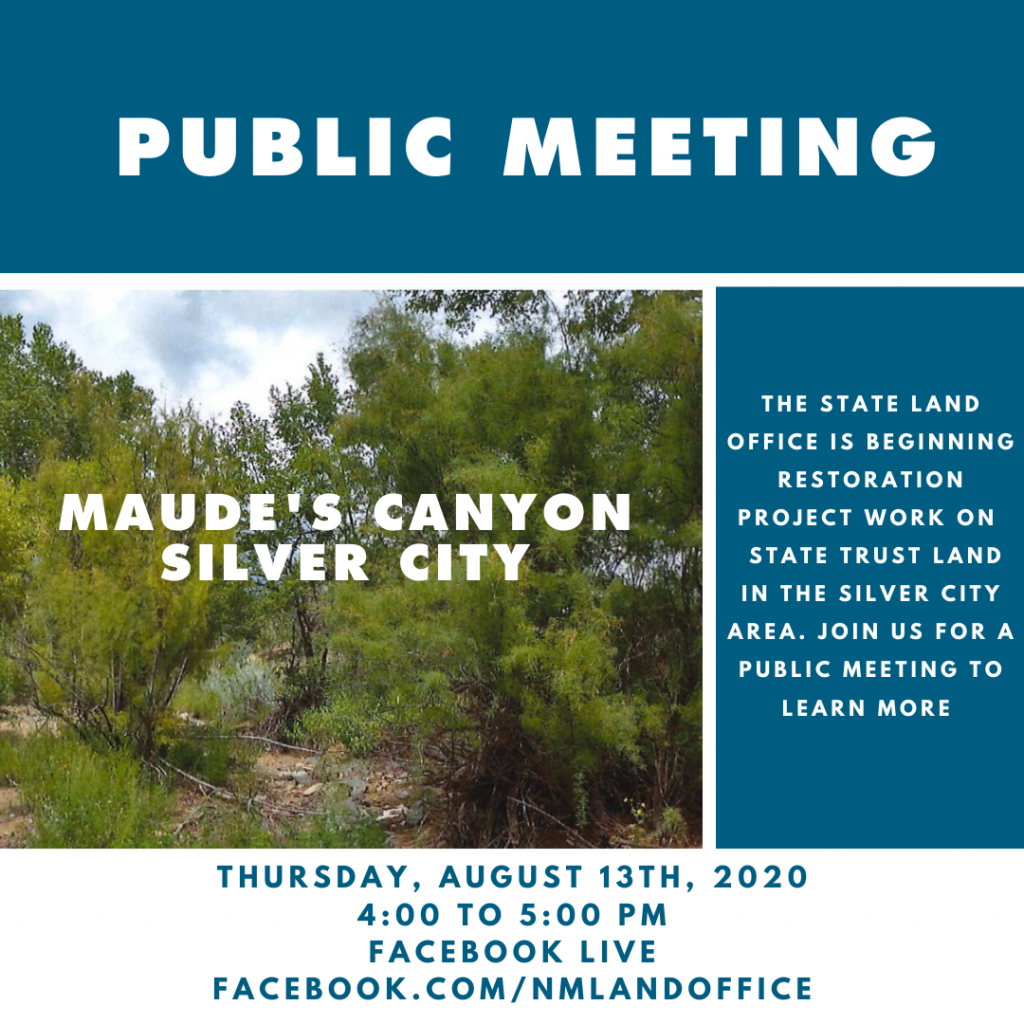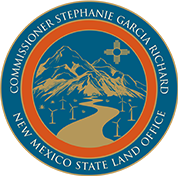
Interested members of the public are invited to a public meeting to learn about a State Land Office restoration project in Silver City.
Public Meeting to be held via Zoom on Thursday, August 13th from 4:00 to 5:00 PM
You are invited to a NM State Land Office Zoom meeting.
When: Aug 13, 2020 04:00 PM Mountain Time (US and Canada)
Register in advance for this meeting:
https://zoom.us/meeting/register/tJcud-ytqDotG9Q_G2Av9PV7NSv4IWFVkasV
After registering, you will receive a confirmation email containing information about joining the meeting.
This meeting will also be Livestreamed at www.Facebook.com/NMLandOffice
Project Details:
The Maude’s Canyon restoration project in Silver City seeks to restore desired conditions within a riparian corridor on state trust land that is currently supporting non-native, invasive plants such as Siberian elm, Russian olive, and salt cedar. Invasive species will be removed to improve ecological function and favor native species such as willow and cottonwood. Additionally, adjacent meadows will be restored that have been threatened by juniper expansion. The desired conditions will provide increased flexibility for fire suppression and management if necessary due to close proximity of homes and businesses. Secondary outcomes will include a more diverse plant community including grasses, forbs and shrubs and enhanced habitat conditions for wildlife.
Riparian Restoration:
• Target species for herbicide treatment include tree of heaven, salt cedar, Siberian elm, and Russian olive.
• Manually apply Garlon 4 Ultra at a rate of 3 quarts/ acre with a basal oil at 25% volume to volume. A blue indicator dye should be added to the spray mixture to show prior treatment of stumps. Do NOT spray this mixture in the river/irrigation canals/ditches or other areas where water is present. Establish a buffer of 10 feet to prevent contamination of water sources.
• Extreme caution should be taken to avoid spraying willows, cottonwoods, and other native vegetation. Consider all factors such as drift and wind speed/direction to avoid contacting willows, cottonwoods, and native trees or shrubs with herbicide.
• All suckers/saplings located inside of or within 1 O feet of a water source must be removed by hand.
• A basal bark treatment must be applied to individual saltcedar, Siberian elm, and Russian olive:;; 6 feet tall or with stems less than 6 inches in basal diameter. Spray should be applied from the base of the stem to a height of 12-15 inches above the ground, thoroughly wetting the stems but not to the point where herbicide runs off and puddles.
• A cut-stump treatment will be performed on all mature non-native, invasive tree species including salt cedar, Russian olive, and Siberian elm. All stumps will be cut to within 5 inches of the ground.
All woody material (target species) greater than 3 inches in diameter will be limbed and laid flat on the ground. All woody material (target species) less than 3 inches will be lopped and scattered not to exceed a height of 8 inches.
• All junipers within the riparian zone will be cut, lopped, and scattered not to exceed a height of 8 inches.
• Herbicide applicators must have all certificates or licenses required by
state and federal laws.
• All herbicides must be stored, mixed, applied, stored, and disposed of
according to the specific and detailed information outlined on the label.
• In advance of pesticide use, safety protocols will be developed for storing, mixing, transporting, applying, handling spills, and disposal of unused
herbicides and containers. Applicators must wear all protective gear
required on the label of the herbicide that is used.
• Contractor is responsible for ensuring an effective herbicide treatment. Considerations for an effective application include, but are not limited to, mixture rate, water chemistry, weather conditions, potential precipitation following application, and proper timing with understanding of target plant phenology.
Meadow Restoration:
• Remove approximately 80% of juniper trees of treatment area. Junipers with smallest diameter should be targeted for removal.
• Retain 20% of largest trees in mosaic variable shaped groups.
• Distances between untreated areas should vary depending on topography and existing vegetation structure.
• Treated and untreated areas should be irregular in shape and follow
natural contours.
• Retain deciduous shrub species where possible. Decadent shrubs may be cut to stimulate growth.
• Retain all snags greater than 8 inches DBH for wildlife habitat.
• No leave trees will be limbed, pruned, lopped, or altered in any way.
• Mastication treatment should go all the way to the ground.
• Mastication depths should not exceed 3 inches. Masticated material
should not exceed 2 feet in length.
• No new roads will be created. Any temporary access routes will be closed after use with slash placement and water bars if needed.
The entire project encompasses 30 acres for mechanical thinning.

